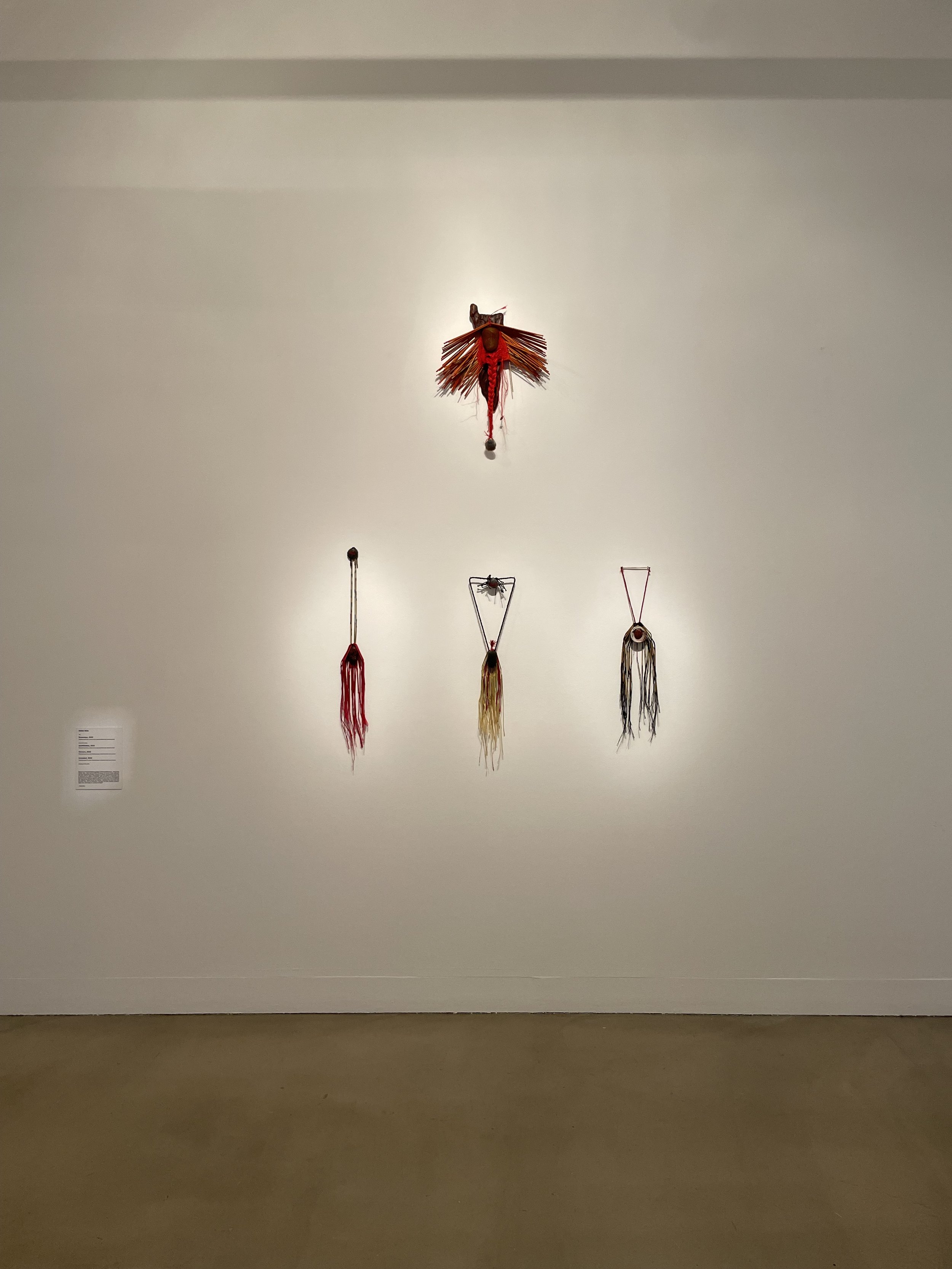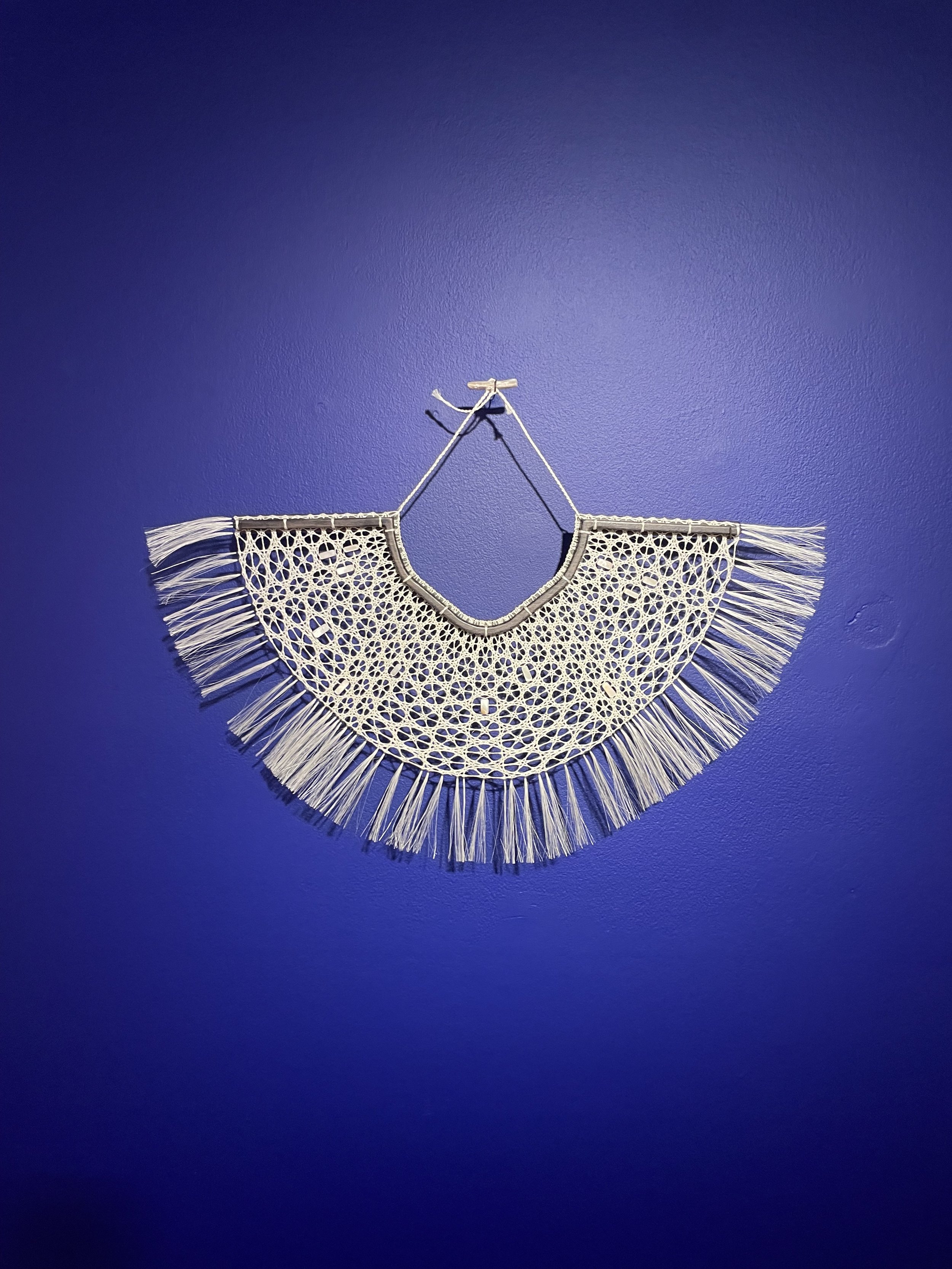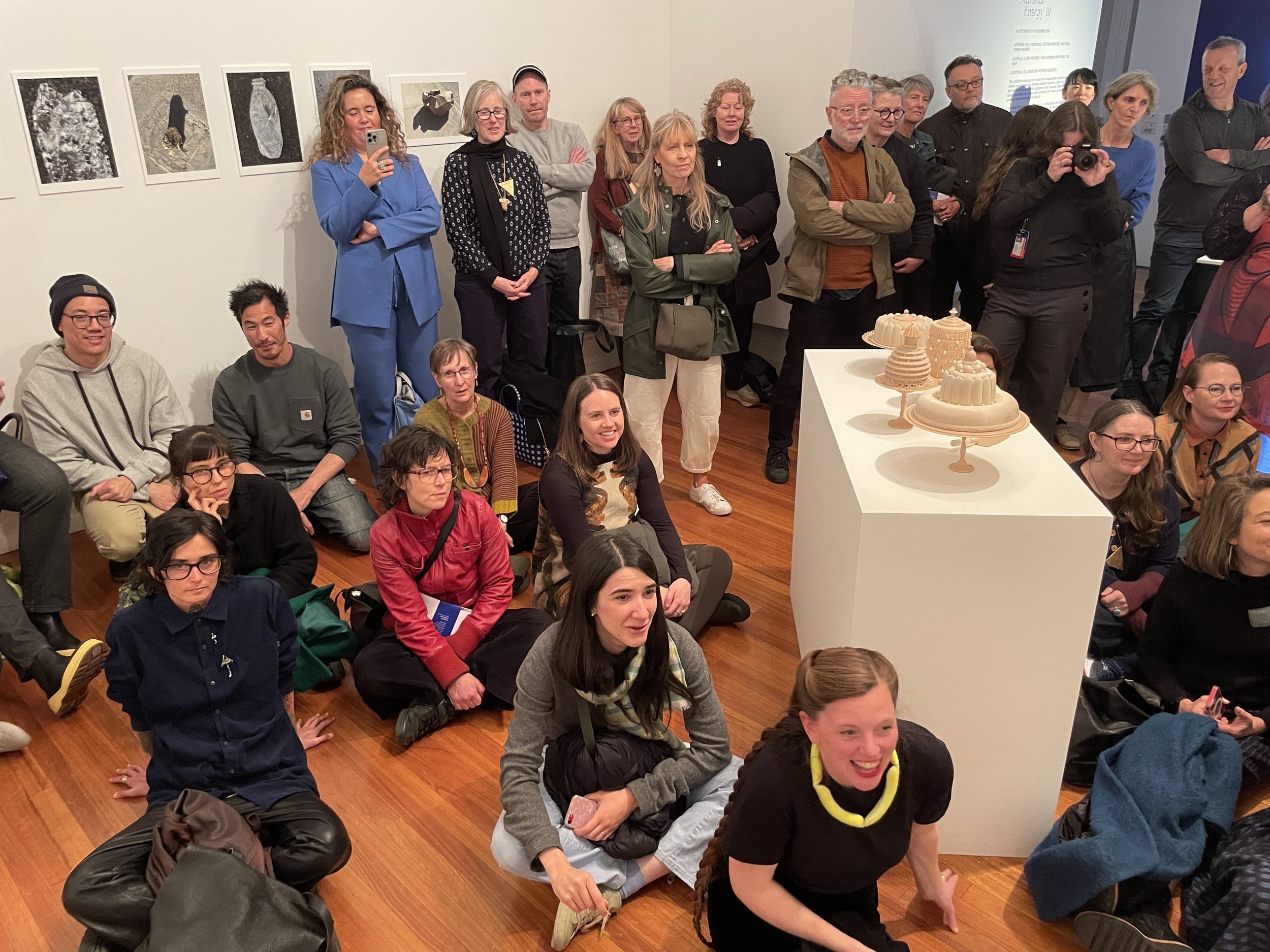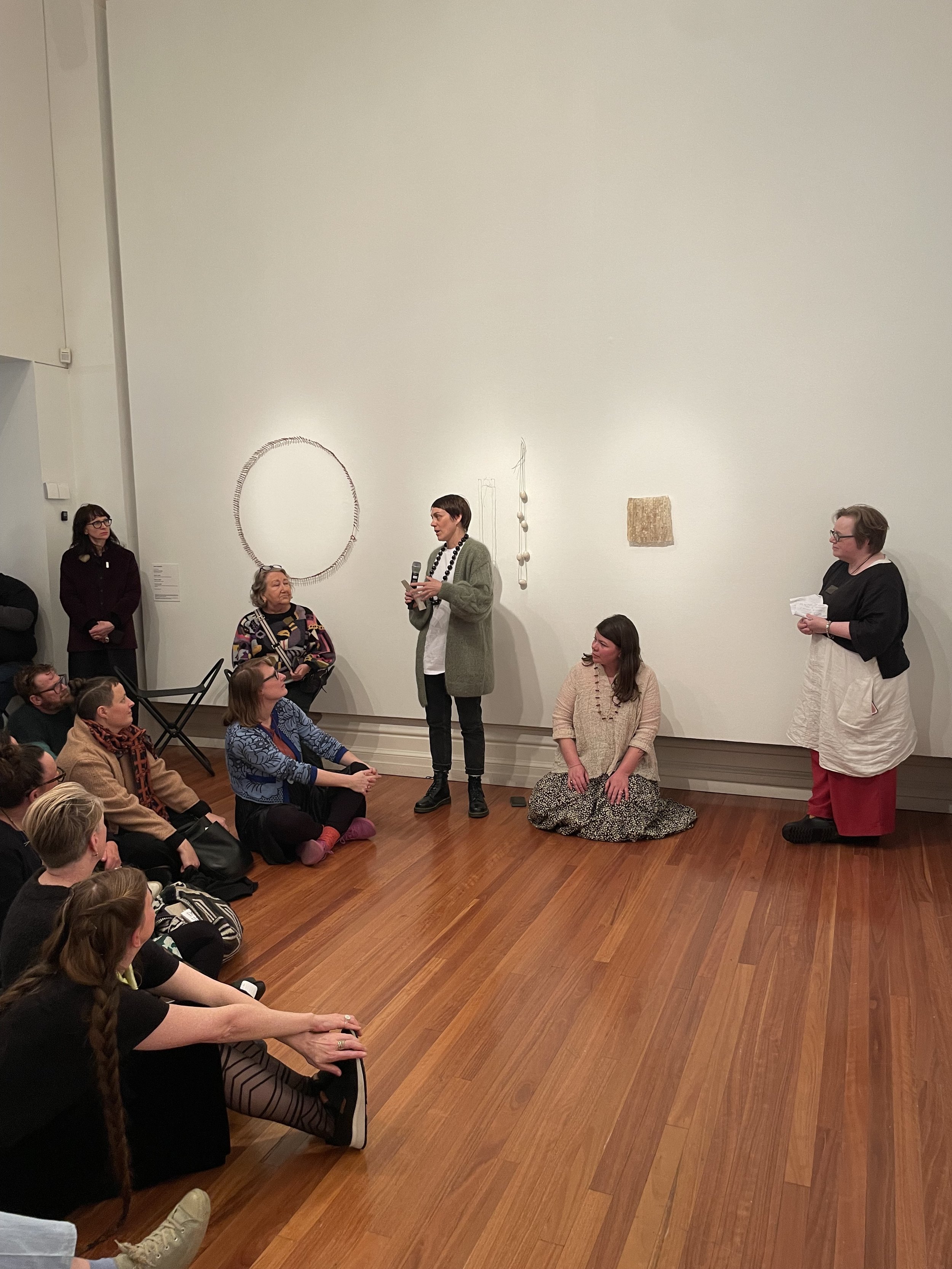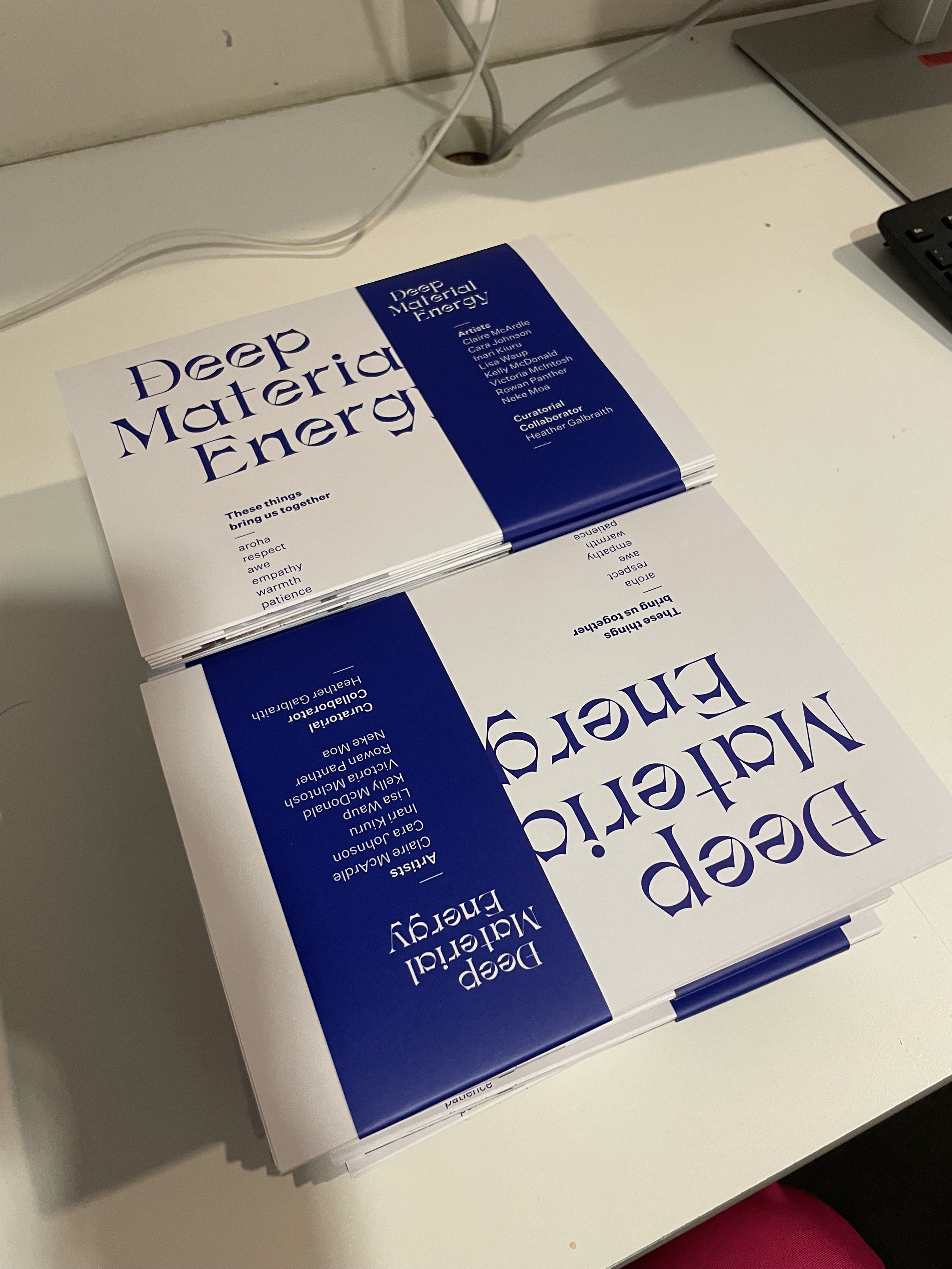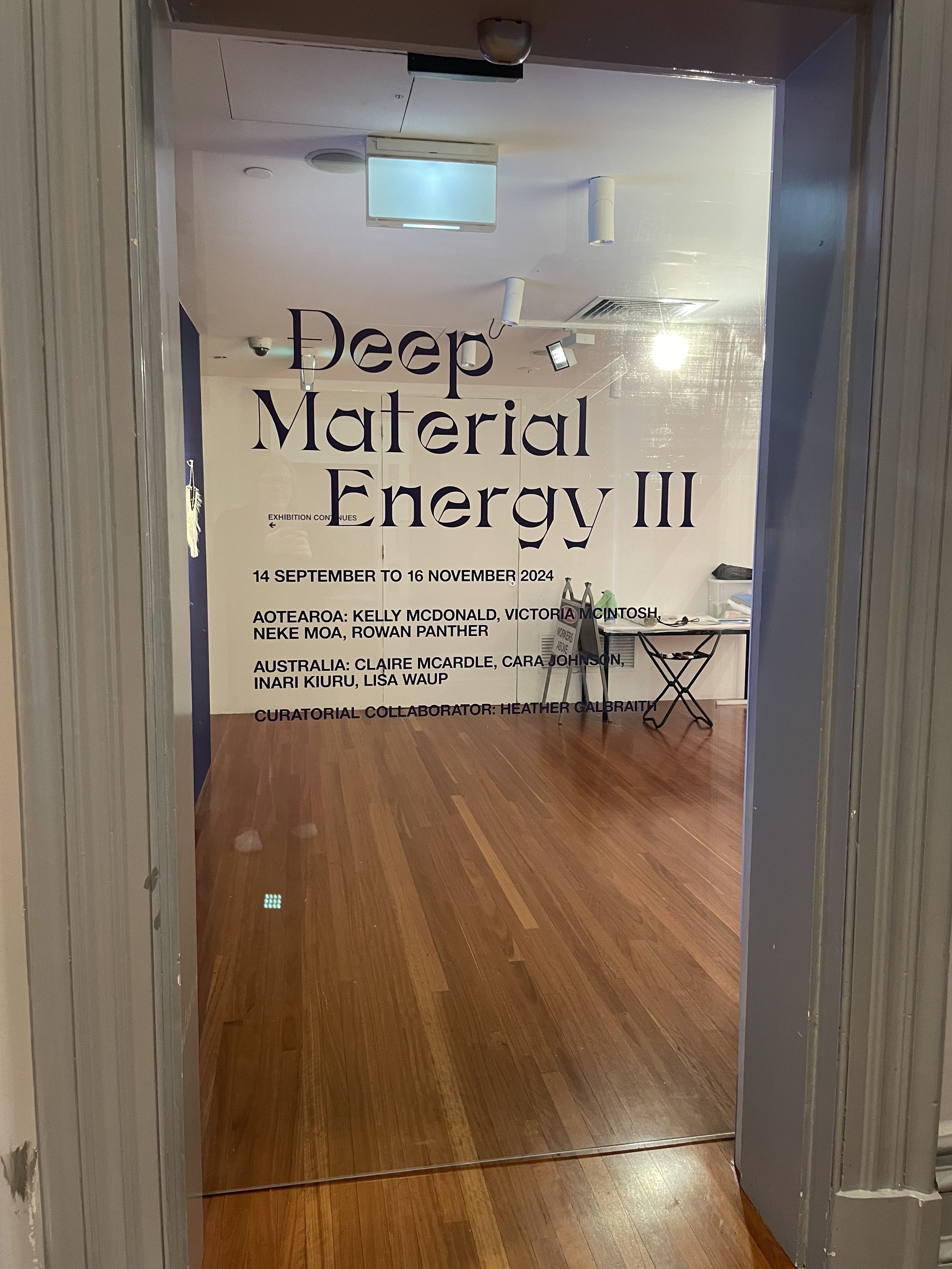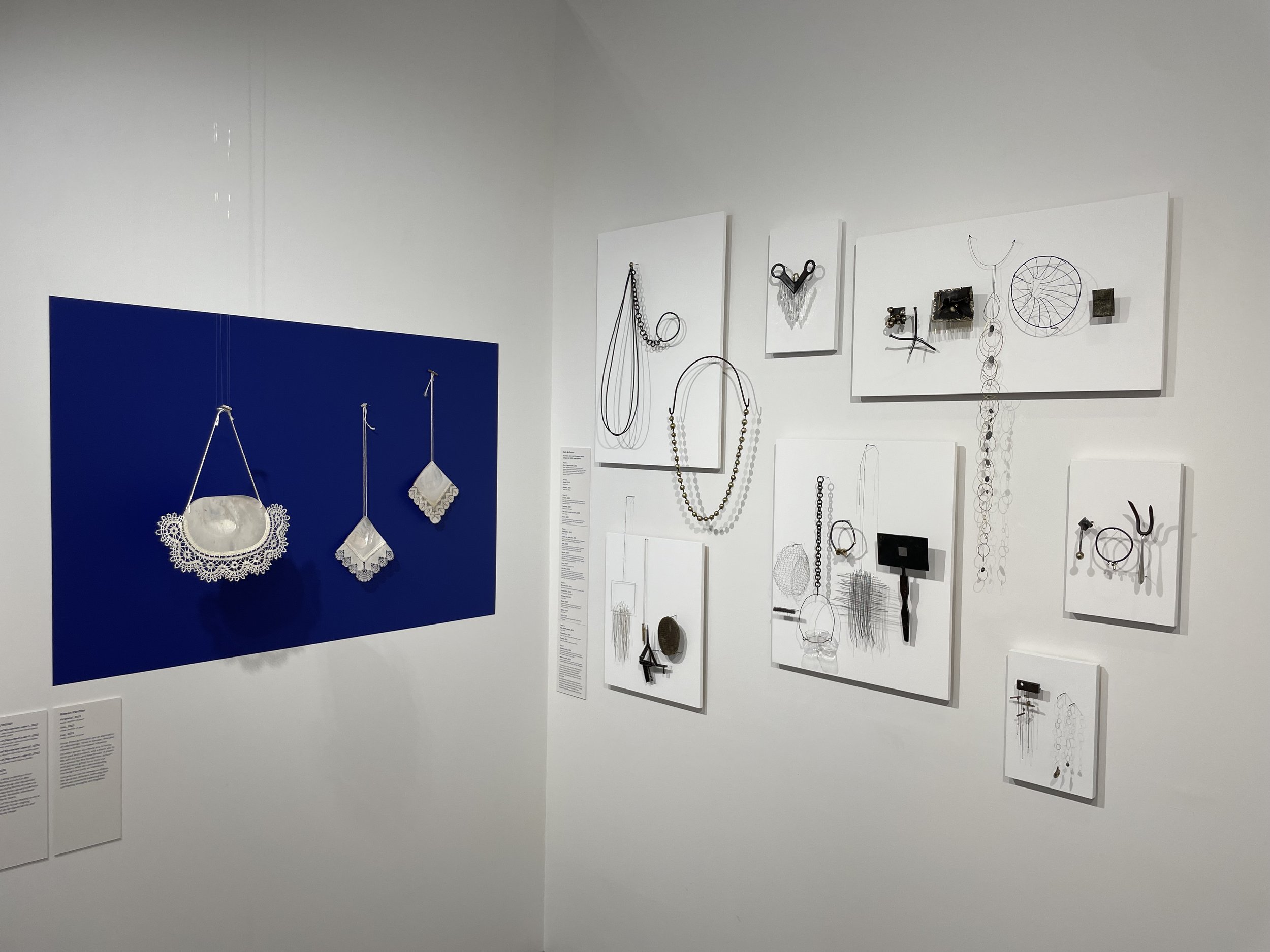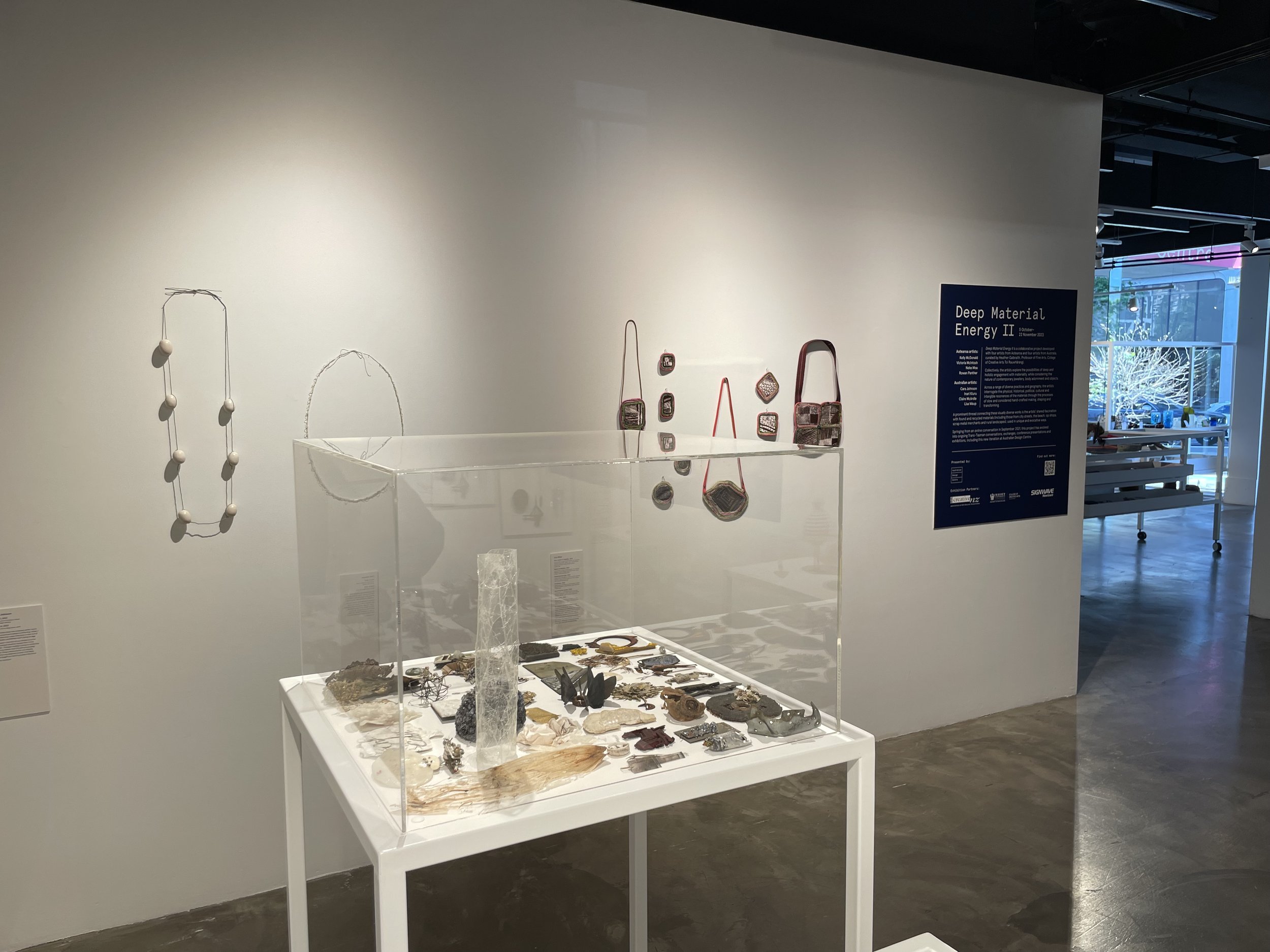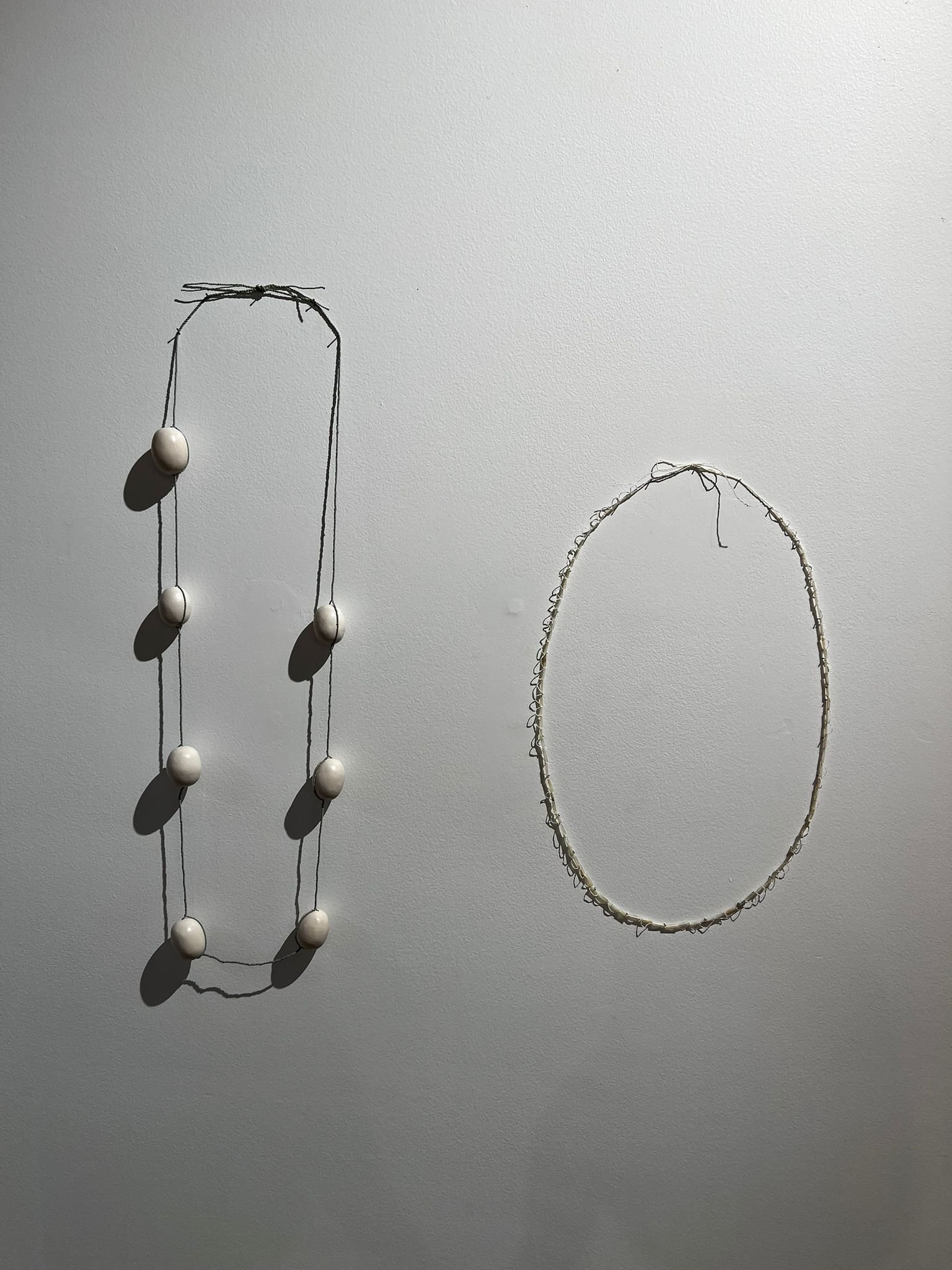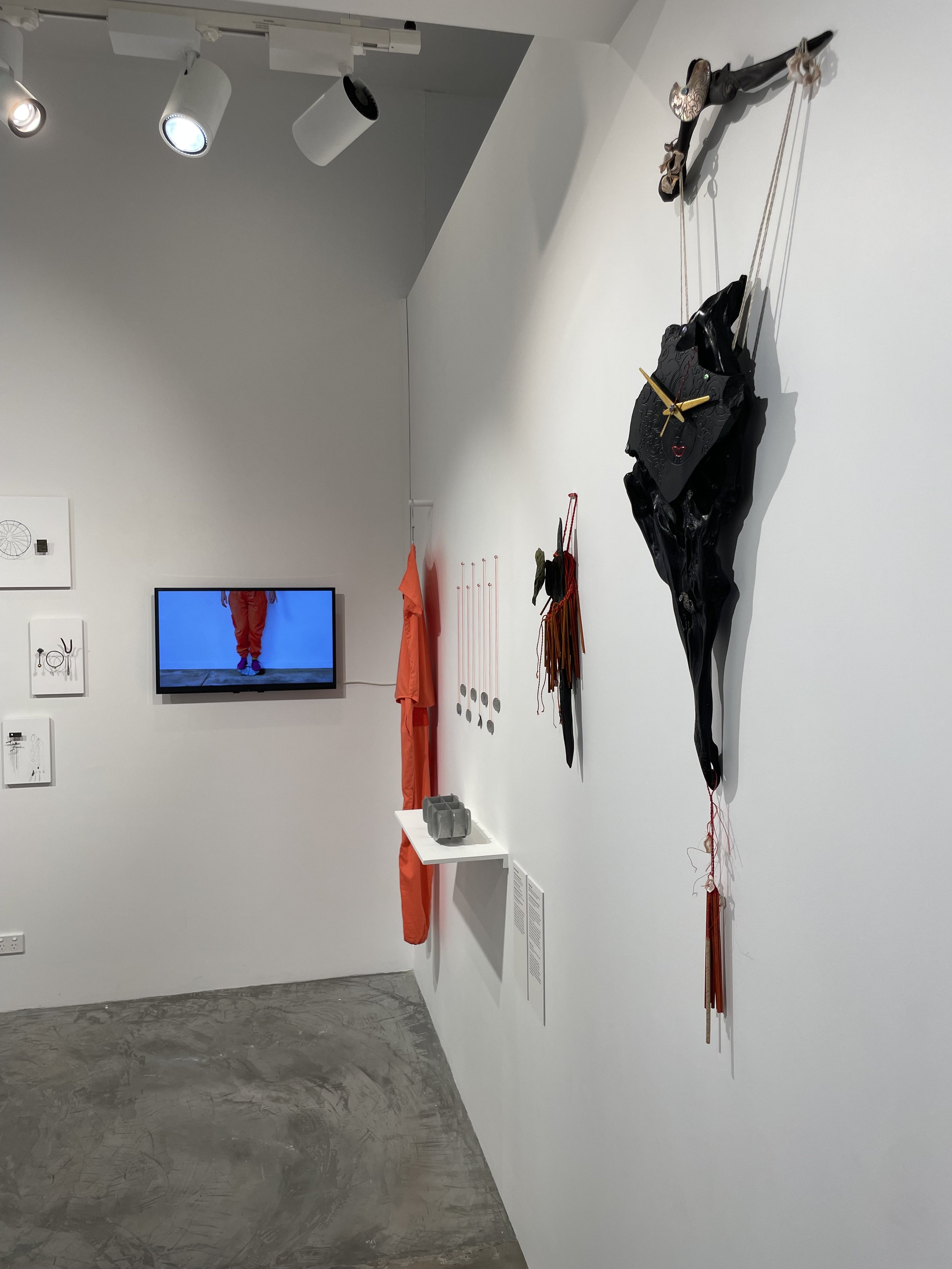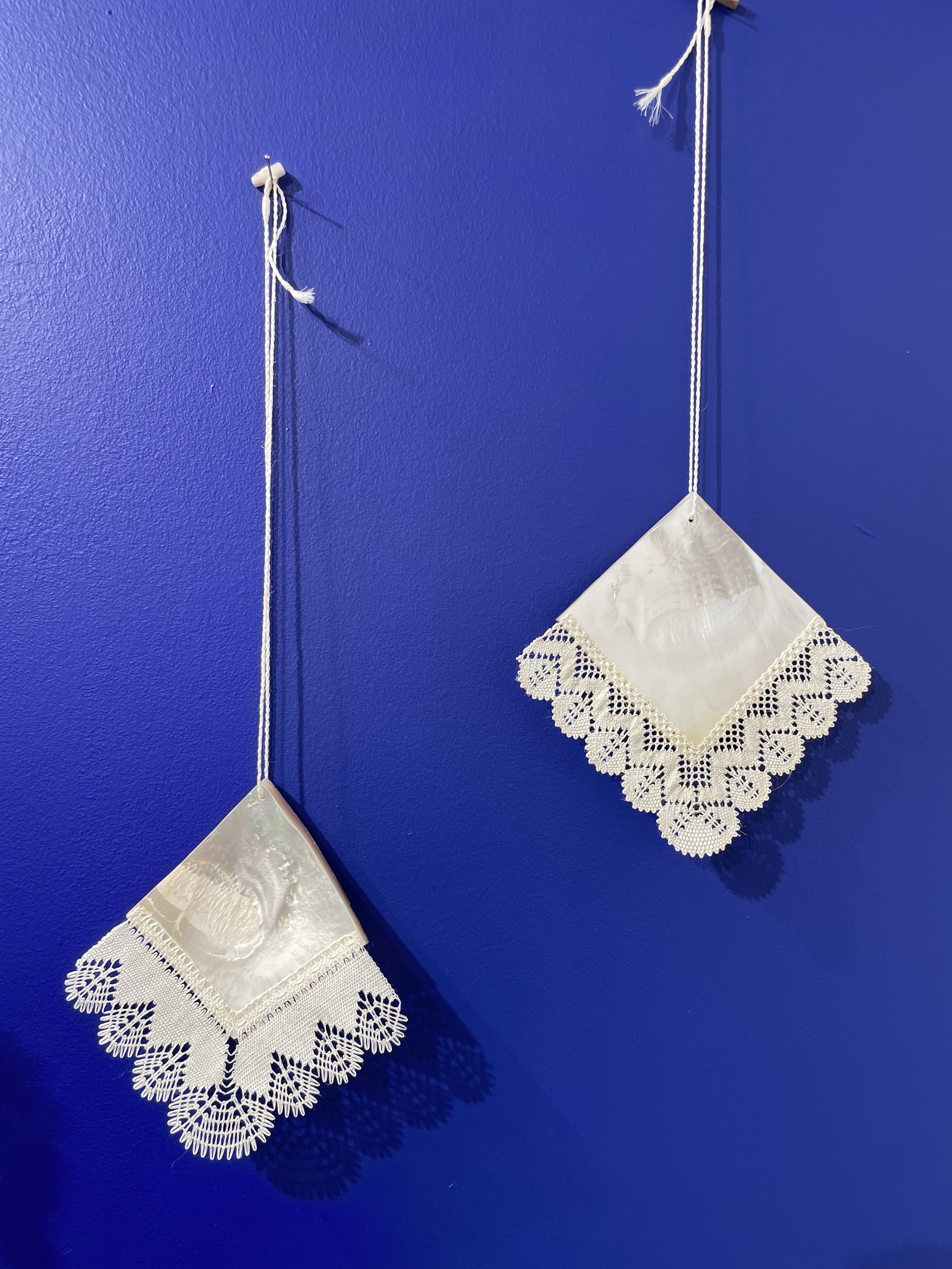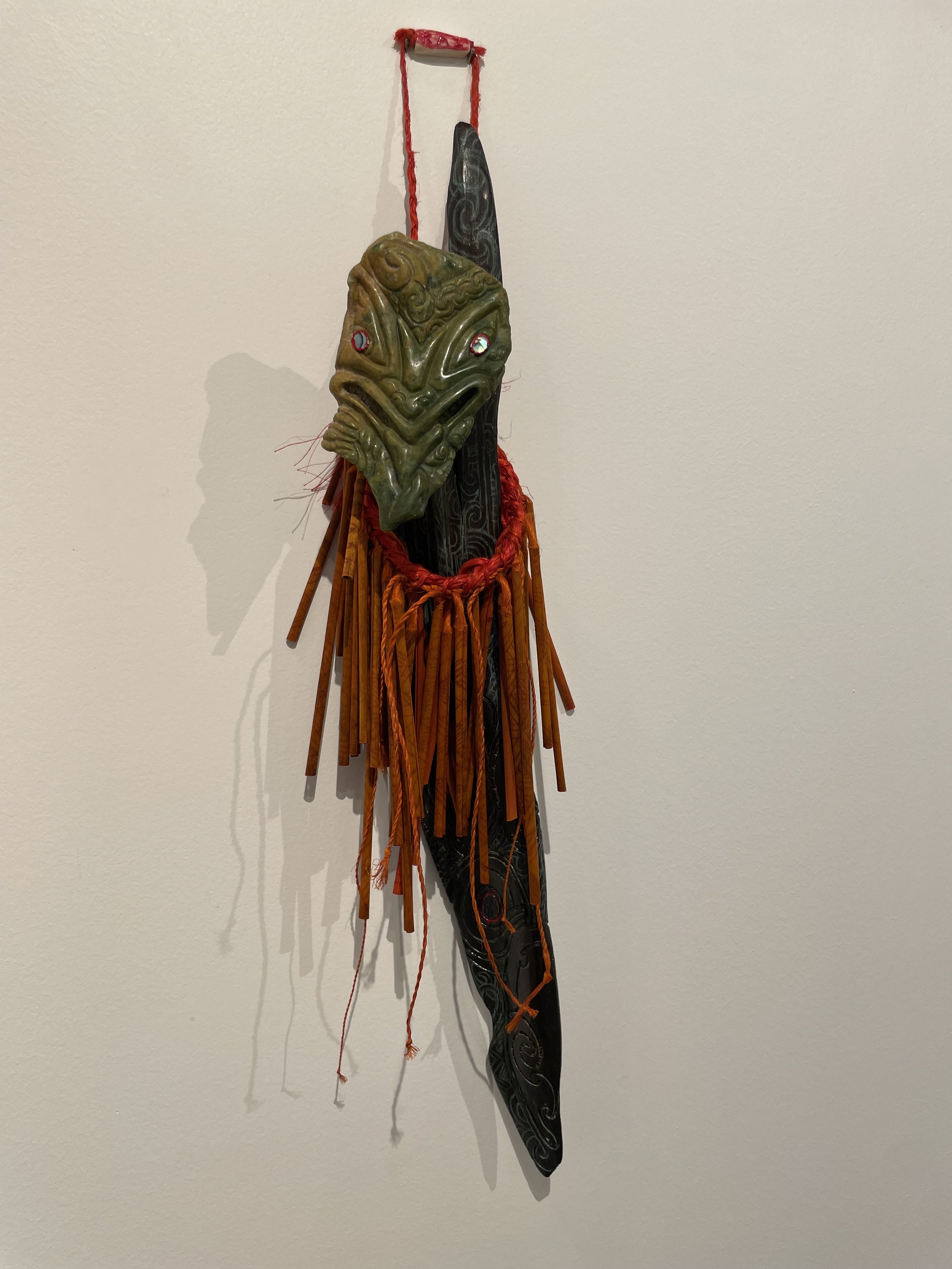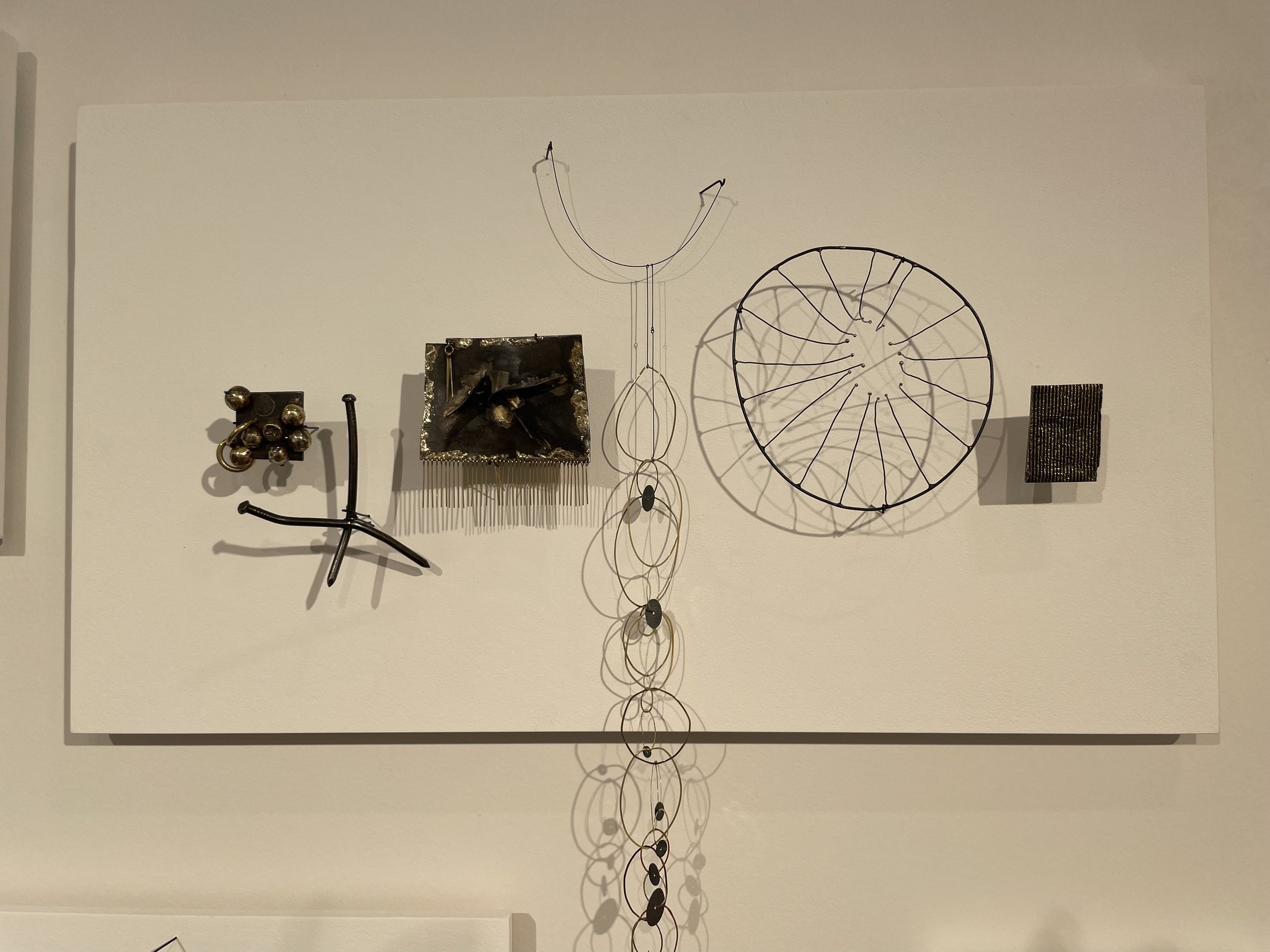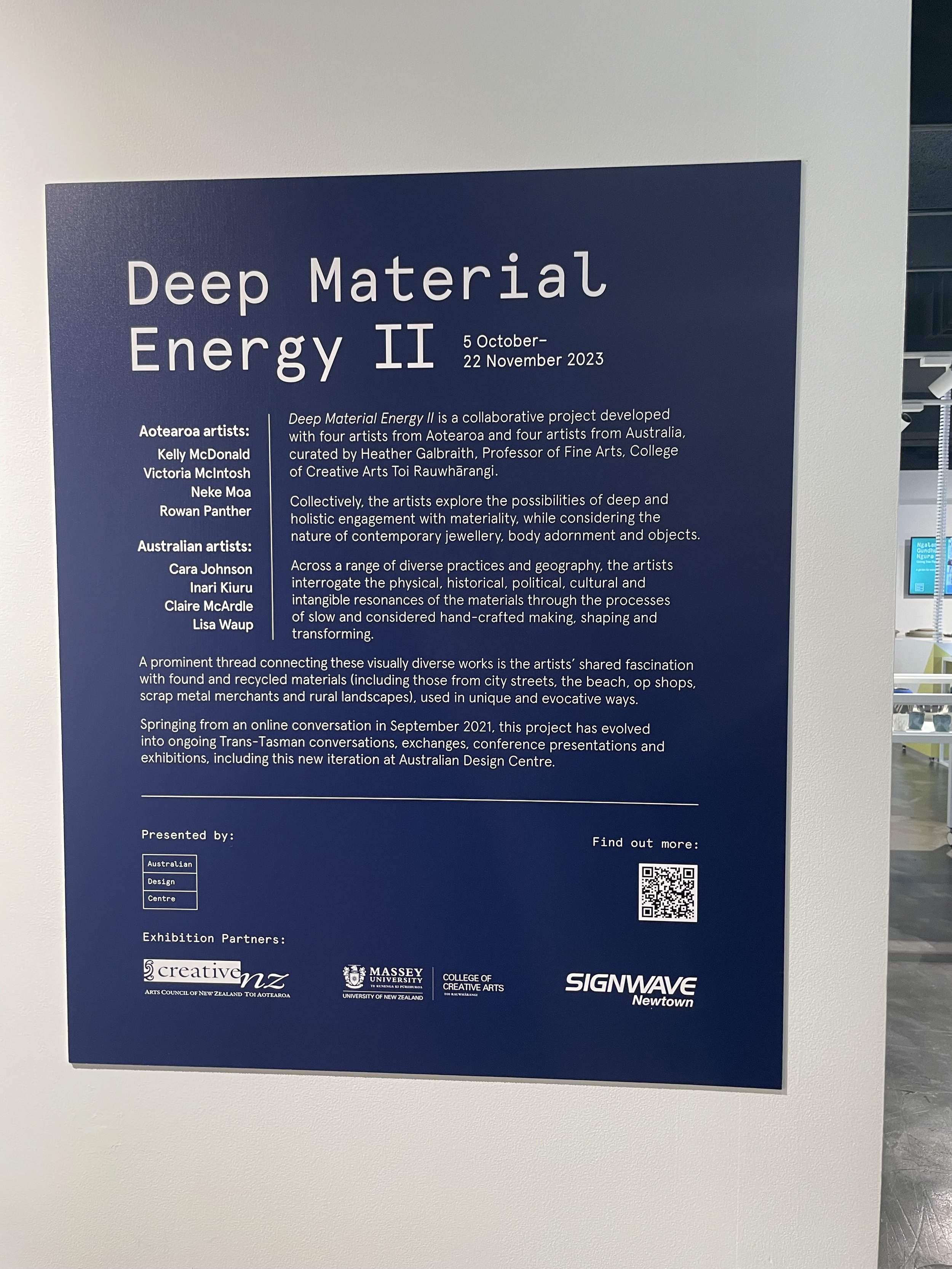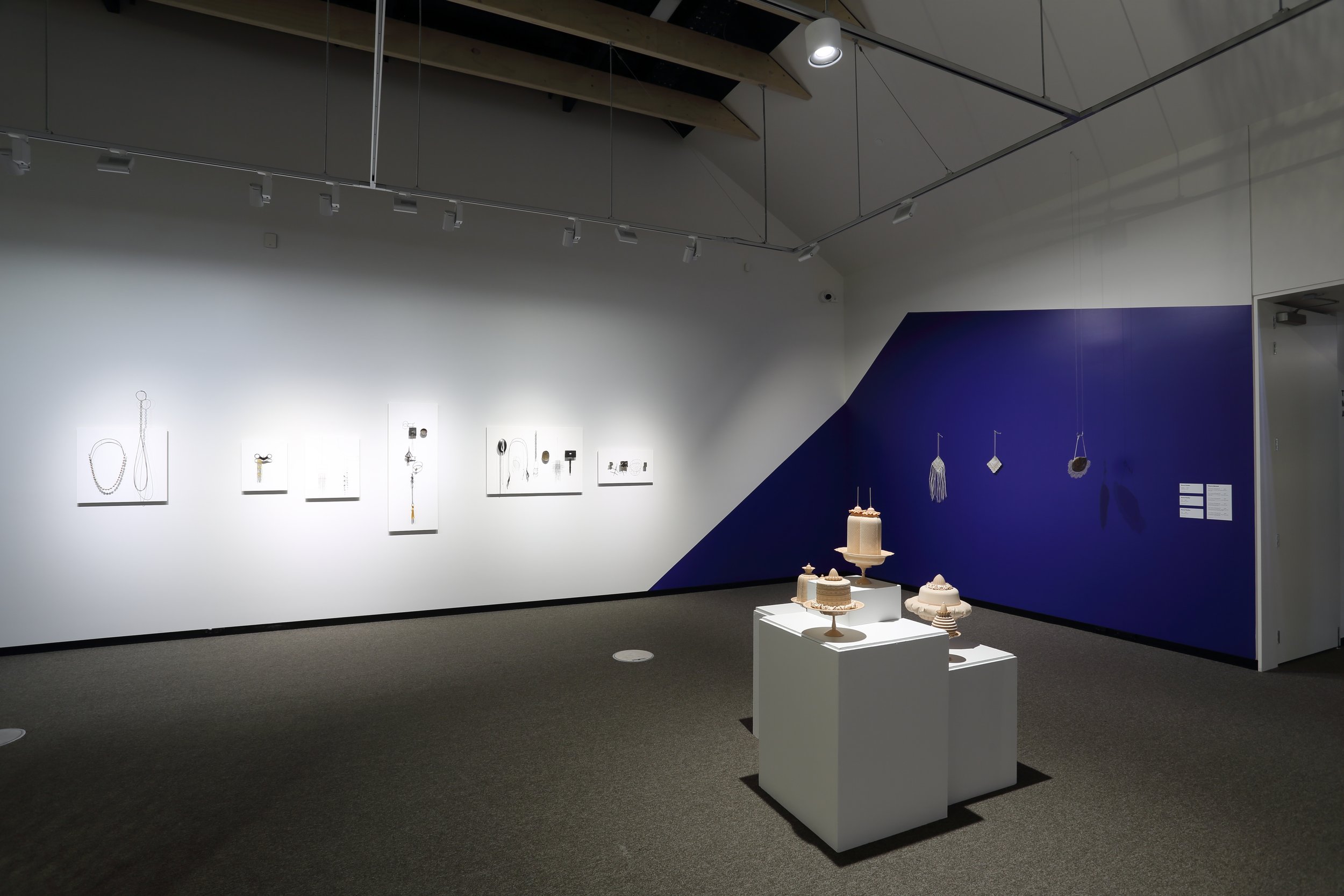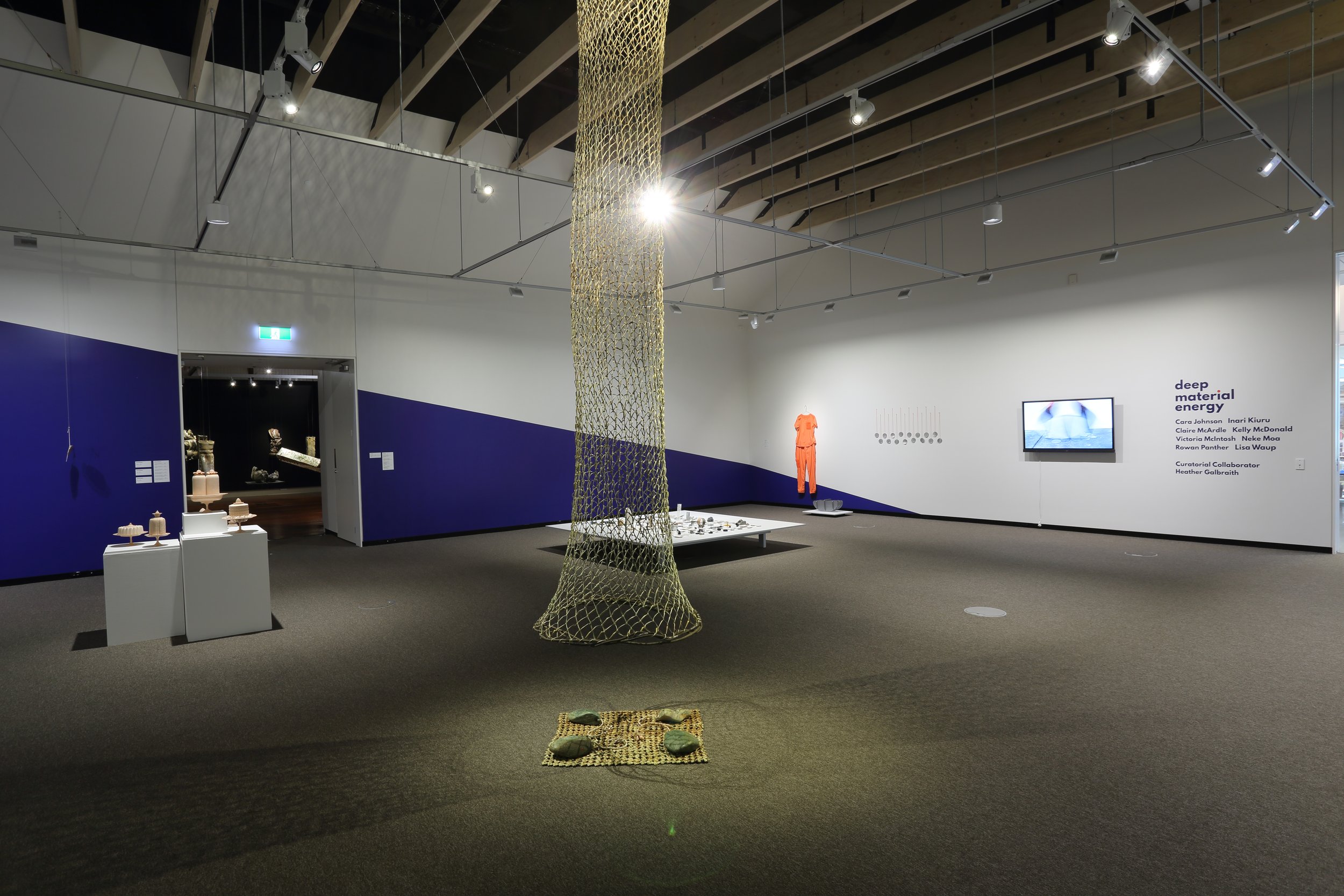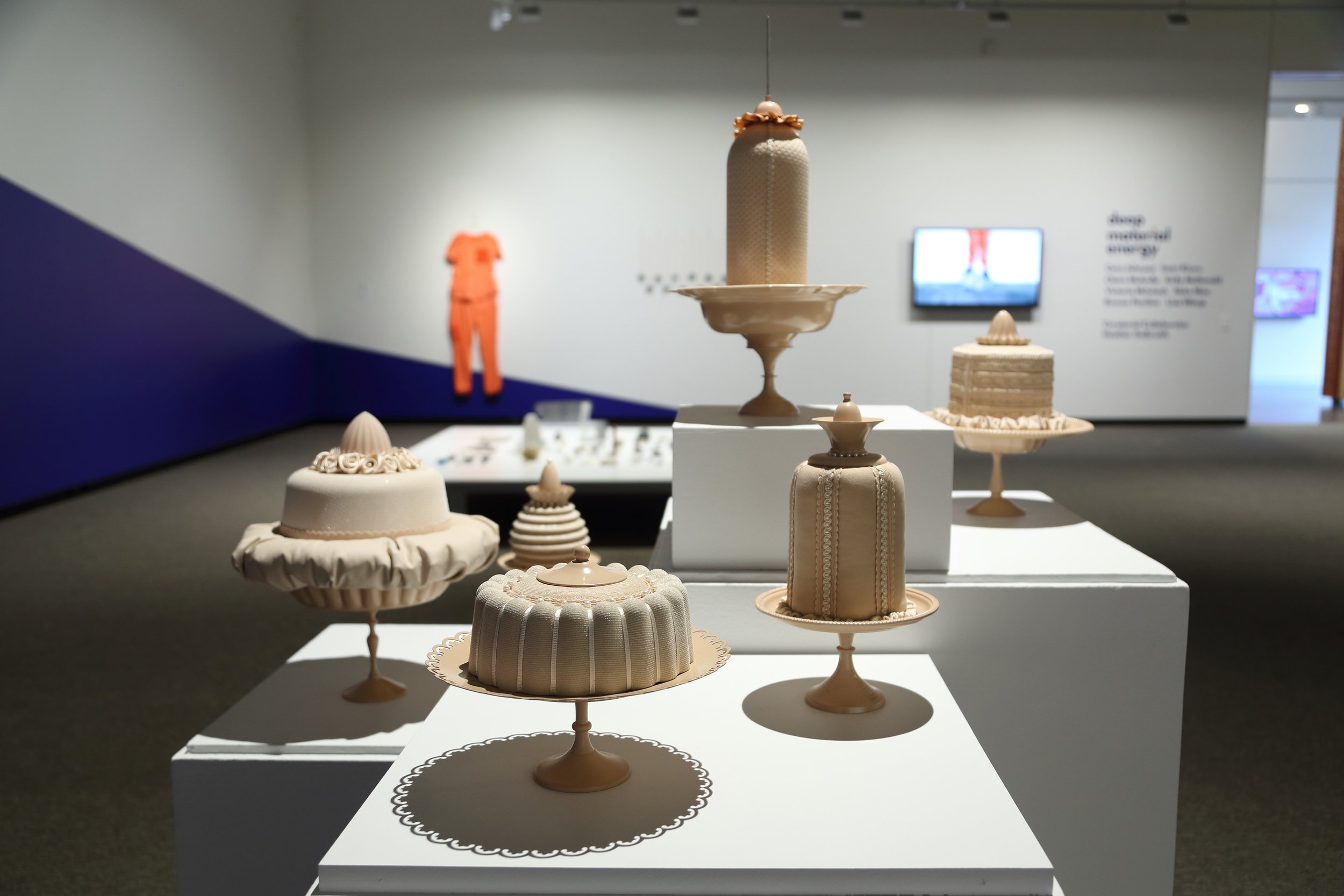Blog
Deep Material Energy III at RMIT Galleries
Deep Material Energy III opened at RMIT Galleries on 14 September 2024 and closed on 16 November 2024.
We had the pleasure of working with the RMIT crew (Helen Rayment, Julia Powles, Jemima Penny, Erik North and more!), to realise this third exhibition incarnation, which brought into play two new works by Inari Kiuru, and two new pieces by Rowan Panther (combining a video process work with the new piece Wayfinding for the disoriented), a meld of existing and new pieces by Cara Johnson, Kelly McDonald, Neke Moa and Victoria McIntosh. The exhibition also had a new iteration of Shoe Rockers by Claire McArdle, where for the first time a pair of shoe rockers were used to rock and imprint/emboss the aluminium pendant pieces, and this also resulted in a new performance action documented in video that was shown alongside the neckpieces, the Outfit, and the Shoe Rockers.
As has been the case with each exhibition iteration, there is ebb and flow, and new conversations with space, and with bringing groups of work together into new or ongoing conversations with each other.
As the exhibition opened right at the start of Radiant Pavilion, we were thrilled to have a full house for a Makers’ conversation on the opening day, brimming with jewellers and craft/object makers, collectors and fans. This was such a brilliant event, after a brief intro from curatorial collaborator, each DME maker present go to ask another one questions, and also have a chance to answer one question from another of the DME crew. Some images of this opening day event are presented here.
We also premiered at the opening the new Deep Material Energy publication, designed by Anna Brown, with essays by Heather Galbraith and Mel Young and texts on each of the makers, which was offered free to visitors t the exhibition. It is in the form of six double-sided long folding sheets, with a chronology of the DME project to date, an observation on the things that bring this group together, a text ‘You have entered a force field’ by Sydney-based maker/educator Mel Young, and sheets pairing a maker from Aotearoa with a maker from Australia (which can be shuffled in any order you desire). If you would like a copy of this publication, please email us and we will sort you out!
Another ace feature on the RMIT Galleries website, is a virtual walk through of the exhibition, so even if you were not able to make it, you can still get a sense of how it looked and felt.
Maker talks
On 6 and 7 October 2023, two Makers’ talks were held at the Australian Design Centre, facilitated by curator Heather Galbraith - featuring presentations by Inari Kiuru, Rowan Panther, Claire McArdle, Kelly McDonald, Neke Moa, and Victoria McIntosh.
Two of the presentations can be read on the ADC digital repository - those by Inari Kiuru and Rowan Panther. Click on the images to be directed to the texts.
Both images are courtesy of ADC and were taken by Amy Piddington.
Deep Material Energy II at the Australian Design Centre
Thursday 5 October sees the opening of the second exhibition iteration of the Deep Material Energy project. Despite some pretty gnarly travel arrangement hiccups which saw a number of makers have to re-route and re-schedule, the four makers from Aotearoa (Victoria, Kelly, Rowan and Neke) have arrived for the install and opening, along with Inari and Claire from Naarm/Melbourne. Cara and Lisa (who are both undertaking artist residencies currently) are connected by phone and screen. Many of the group have been able to meet in person for the first time and exchange hugs and warm greetings.
The team at the Australian Design Centre (ADC) have been so welcoming and it has been great working through the installation with Director Lisa Cahill, Associate Director: Programmes and Partnerships Debbie Abraham, and Creative Producer Rhadi Bryant. The spatial configuration at the ADC is distinct contrast to The Suter Gallery, this is a much tighter hang in a rectangular space, adjacent to the entrance and the incredibly well-appointed shop profiling craft/object works from all over Australia.
We worked to weave the more intimate hang, utilising height to draw works together in cosy proximities. There are a strong proportion of new works in the exhibition; Claire McArdle has re-worked her contribution to include a half-size rocker, and neckpieces, which are not only half the size, but also half the number (from 16 to 8). The new video work documents Claire atop the little rocker, imprinting the circular aluminium disc forms, with a very different rocking gait. There a considered conceptual and processual adjustment that includes all the pieces (apart from the Outfit) downscaled, even down to half the number of dyed recycled bed-sheet threads used to make the neckpiece strings.
Cara Johnson has made Flock I, a new neckpiece which incorporates sections of quills from her flock of chickens that was brutally killed by a marauding fox, which sits to the right of Flock II that was shown in Nelson, which comprises hand-carved and painted willow egg forms strung on a length of finely twisted found silage wrap. Cara continues to consider how we live with and connect to the companion species we share the land with, including the creatures we tend and those that may hunt them.
Victoria Mcintosh has made a suite of four new Desserts of Discontent confections, complete with a companion cake slice. The variety of cakes on offer has expanded to include the delicious display of fringing and fresh water pearls on Cake I, which feels like the show pony of the feast before us. The meticulous finishing on these pieces, is a testament to Victoria’s textile and object making skills, but also is aligned with the criticality present within the conceptual underpinnings of the work, specifically around how aspects of control around body image, and gendered behavioural expectations remain prominent. The names of control wear (which feature strongly in Victoria’s work) may have changed over the years, from corsets to panty girdles, and onto Spanx or Skims, but the imperative to control wobbly or ‘ungainly’ aspects of our bodies, remains frighteningly prominent.
Lisa Waup has added a new three-some of neckpiece and two earrings Two Realms (earrings) and Revisiting Two Realms (neckpiece), also working with screenprinting on dyed ostrich leather, emu feathers, fresh water pearls, reflective thread, wool, cotton and copper wire. The new pieces also riff off realms being brought into contact with one and other, two units, one on top of each other, achieving an asymmetrical balance, and in good company with the groupings shown in Nelson; Four Realms of Stability, and Protected (and their accompanying earrings).
Rowan Panther has brought Fa’afetai, and Lua (both shown in Nelson) and added Tolu, a new piece for the ADC show. The works are hung against a deep resonant midnight blue (which we carried through from the Nelson iteration), with Fa’afetai hung out from the wall to enable the piece to hang in a way that viewers can appreciate to weight of the shell form (Australian yellow mother of pearl) and also regard the ‘thingness’ of the muka (New Zealand flax fibre) lace that curves around the bottom and sides of the oval shell form.
Kelly McDonald has re-worked her panels in A Curious Story Told in Several Parts; Chapter 2, bringing hot off the desk new pieces into conversation with works shared in the Suter show, and older pieces that have remained touchstones from when they were fabricated years (and in one case) decades prior. Kelly’s investigation and transformation of found and recycled metals has had such a strong aspect of continuity through years of her practice, but also tests and experiments with curiosity and playfulness, resulting in a suite of seven ‘pages’, that collectively build this chapter of material, autobiographical, and speculative wonderings.
Inari Kiuri has re-worked Eye, the beholder and Eye, the beholder II and a book of images into a smaller configuration, this time atop a raised plinth. There are many of the treasured objects featured in Nelson, the shattered crystaline tower, the compressed fake flower, the sparkly minuscule pompom. These are joined by friends from botanical realms (that were not possible to bring into Aotearoa), all collected through forays through Inari’s neighbourhood of Brunswisk, Naarm, where she undertakes walks and explorations of attuned observation and collection. In the bound book of Giglée prints on archival stock, Inari shares images made between 2013-2023 of moments where road or pavement, comprised of crushed stone, asphalt and other composites host objects that have been discarded or abandoned. These highly visceral, tactile close-ups speak grittily of our urban world while also transporting us through an adjusted lens, an attentive process of looking, beholding and recording.
Neke Moa contributes two works new to the DME configuration; He aha te wā? What’s the time? and Papaīra. These entities are time travellers, connecting (through collaboration with Atua - deities/knowledge holders) the maker as creative channeller and interpreter. The collaboration continues into connecting with the realms of the ocean (moana) and land (whenua). The materiality of these pieces brings together muka (New Zealand flax fibre), pounamu (New Zealand greenstone), paua shell, ring shells, and driftwood, with other processed materials including paint, pencil, and a clock mechanism, through which we can navigate what take on time we choose to align with.
Deep Material Energy at
The Suter Art Gallery
On Saturday 18 February 2023, Deep Material Energy opened at The Suter Art Gallery in Nelson, Aotearoa. Aotearoa-based makers Kelly McDonald, Victoria McIntosh and Neke Moa, joined curator Heather Galbraith and The Suter staff (curator Kyla McKenzie, Director Julie Catchpole and ace installer Doug) for a hands-on installation. The ongoing effects and devastation wrought by Cyclone Gabrielle were still being felt (particularly in the North Island of Aotearoa), with one of our contributing makers Rowan Panther being caught in the hard-hit Hawkes Bay, unable to leave until road clearances progressed.
Rowan’s work was dispatched the week following the opening, installed and is now warmly welcomed into the exhibition. Neke, Victoria, Kelly, Heather and Paula Conroy (collaborator with Neke Moa) shared insights about the exhibition, their own work and the works of the four Australian-based makers Cara Johnson, Claire McArdle, Inari Kiuru and Lisa Waup, in an hour long public programme on the afternoon of the opening. We missed our Australian project members, but the WhatsApp channel was afire with images, progress updates, specific installation questions and initial documentation.
We thank The Suter staff for their very genuine welcome and for supporting this project (including @sarahmclintock who first agreed to the inclusion of this project into the programme prior to her departure to take up the Directorship of Aratoi in Masterton). Installation views taken by John-Paul Pochin, through The Suter Art Gallery.
Deep Material energy - information panel
Claire McArdle, Cara Johnson, Inari Kiuru, Kelly McDonald, Victoria Mcintosh, Neke Moa, Rowan Panther, Lisa Waup and curatorial collaborator Heather Galbraith.
These contemporary jewellery/object practices all demonstrate a deep connection with, and curiosity about, the materials they work with. The works explore the cultural and political resonances of the materials, and processes of making, shaping, and transforming. The works also consider the context of working in Aotearoa and Australia, within Moana Oceania.
A prominent thread connecting what may appear to be visually diverse works, is a fascination with found and recycled materials (including those from city streets, the beach, Op Shops, scrap metal merchants, and the rural landscape). Each maker interrogates the physical, historical, cultural and intangible resonances of their materials. Their making processes all employ time-consuming hand-making, as a way of thinking through making, consciously transforming their materials through labour, and imagining their potential.
Contemporary jewellery/object is a wide-ranging discipline, in terms of materials and processes that are used. In the later part of the 20th century there was a strong shift away from thinking about ‘jewellery’ in terms of precious materials (gold, silver, platinum, jewels etc.), towards explorations of concept, context and how non-precious materials could be utilised and transformed in relation to the body. Within contemporary jewellery there are many discussions about whether the pieces produced need to be wearable, or whether it is more important that they relate to and reference the body in some way, rather than be utilitarian. Additionally, makers today draw on different knowledge systems and lineages of object-based making, and not all elect to use the term ‘jewellery’, including Indigenous makers who seek to orient their creative forms in relation to Indigenous practices and knowledge systems, who do not necessarily identify with more Eurocentric traditions of ‘craft’.
Rowan Panther draws on hybrid ancestral lineages; in her case Samoan, English and Irish, and also her contemporary lived experience in Aotearoa. Rowan’s work has been part of a recovery/resurgence of bobbin-lace making, while also interrogating traditions of customary pacific body adornment. In her works here, Rowan brings together hand-made bobbin lace made using muka (prepared harakeke fibres) and shell forms, to create pieces that are both delicate and chunky, vulnerable and weighty. Rowan has described the conversation with the man who sourced the shells who explained that the older the shell, the more disease it accumulates. Rowan was intrigued by how this is a strong analogy for life where being around longer can mean being exposed to more trials and tribulations. The union of the softer, fine lace with the hard protective shell talks to the difficult melding of the hard parts of life and the beauty that is also constantly present.
Claire McArdle has a history of working with metal and exploring ways in which metals such as steel or aluminium can be manipulated and transformed through cutting, rolling, heating (annealing), and imprinting to transform its surface and structural physicality. She has a fascination the labour and physicality involved with these acts of transformation. In Deep Material Energy she combines documentation of her making the sixteen aluminium neck pieces through the rocker tool she has devised (using second-hand aluminium), wearing the garments/uniform she designed and made (from recycled bed sheets). This outfit has affinities with both utilitarian work wear and artist-designed apparel/uniforms from influential 20th century applied art/design movements such as the Bauhaus.
Cara Johnson works with discarded found materials from industrialised agriculture and regenerative planting schemes that try to attend to damages to land and ecosystems that human land use has caused. She collects these materials from rural Victoria (Gadubanud land) where she lives and works, through a process of attentive walking and collecting. They are unlikely materials to create objects of such lightness and detail; baling twine, tree guards, silage wrap, fence posts, combined with organic materials such blackberry, willow, or apple woods. Cara works with minimal hand tools, crafting her pieces through repetition, and through this hand-crafting she gains an intimate knowledge of how these materials behave and are transformed through her labour.
Victoria McIntosh combs Op Shops and second hand stores for materials such as vintage underwear (bras, girdles, slips, trims) and kitchen equipment (plate stands, goblets, lemon squeezers). This body of work brings together fabric and metal components to fashion flesh-coloured fancies that invite thinking about historical and contemporary gender roles, stereotypes and expectations, attitudes in relation to bodies, sensuality, and decoration. Victoria utilises a keen sense of humour to beguile and disarm viewers, luring folk in with the exquisite crafting of her objects.
Kelly McDonald is also an avid collector but her eye is drawn towards harder stuff, in particular tools, apparatus, domestic fixtures and fittings (frequently from traditionally masculine and utilitarian fields) that can be dismembered, re-worked, paired with unlikely material bed-fellows to create installations of objects, constructed and arranged to create narrative sequences. A wry humour is in play here, with moments of absurdist delight and political provocation, particularly in relation to female lived experience.
Like most Finns, Inari Kiuru grew up wandering and seasonally foraging in the forests close by, and now continues to relate to her inner-city environment as if walking in nature. She has documented her neighbourhood in ‘ordinari observations’ blog since 2008, pointing out the extraordinary within the mundane always central to her practice. Inari’s tabletop installation combines discarded matter with transformed, carefully crafted elements (vessels, brooches, earrings), illuminating the potential and poetry of common non-precious materials. Visitors are invited to look closely and consider where they find expressions of beauty and value of all kinds, often in unexpected places.
Neke Moa (Ngāti Kahungunu ki Ahuriri, Kāi Tahu, Ngāti Porou, Ngāti Tūwharetoa) describes her Otaki Beach/Kapiti Coast based practice of making with materials gifted from the environment, as a collaboration with Tohunga and Atua. This series explores the unseen portals that allow wairua to communicate with each other across time and space. This process is called mauri. These stones are holders of mauri. Visible symbols of narratives based on intention, reminders of journeys taken, being travelled and completed, all at the same time. Mauri stones for touching and contemplation. Hovering above the stones a harakeke (flax) kupenga (net) resembles the portal binding wairua together, a symbol of the collaboration between artist, tohunga and atua.
Lisa Waup is a mixed-cultural First Nations multidisciplinary artist and curator born in Narrm (Melbourne). Lisa works across many media including weaving, printmaking, photography, sculpture, fashion, photography, public art projects and digital art. Her work explores the importance of discovery and connection, through tracing lost histories, ancestral relationships, relationship to Country and experiences of motherhood. Lisa shares with us neckpieces and earrings that bring together printmaking, embroidery and weaving.
Deep Material Energy is a slow cooked project. It began late 2020, working towards participating in the festival of contemporary jewellery held in Melbourne Radiant Pavilion. As Covid-19 impacted Melbourne and Aotearoa so significantly, this initial engagement was deferred and in September 2021 Deep Material Energy was officially launched through an online Maker’s Circle Zoom conversation and a website. It will have its next iteration at the Australian Design Centre, Sydney later this year. Emails and a What’s App group has connected the makers through the last two + years, where work progress, studio shots, links to articles and shows, and exchanges around momentous life events (births, deaths, sickness, Postgraduate study) have been shared with warmth and candour. The sense of shared support and acceptance, and getting to know each other over time, has strongly underpinned the development of this exhibition.
Claire McArdle is based in Ballarat, Inari Kiuru and Lisa Waup in Narrm/Melbourne, and Cara Johnson in the Otway Ranges, which are all in Victoria, Australia. Kelly McDonald is based in Te Whanganui-a-Tara/Wellington, Victoria McIntosh in Ōtepoti/Dunedin, Neke Moa in Ōtaki, Kāpiti Coast, and Rowan Panther in Te Tai Tokerau/Northland. Curatorial collaborator Heather Galbraith, lives and works in Te Whanganui-a-Tara.
Deep Material Energy has been supported by Toi Rauwhārangi College of Creative Arts, Massey University Te Kunenga Pūrehuroa.
Heather Galbraith
List of works: Deep Material Energy at The Suter Art Gallery
List of works (clockwise from foyer)
Cara Johnson (left to right)
Unravelling III, 2023 found baling twine, courtesy of the artist
Flock I, 2023, found tree guards, found baling twine, iron, courtesy of the artist
Flock II, 2023, willow, found silage wrap, paint, courtesy of the artist
Lisa Waup (left to right)
Four realms of stability, 2023, neckpiece; screen printed on dyed ostrich leather, ink, assorted feathers, fresh water pearls, wool, cotton thread, reflective thread waxed cotton thread, buttons, copper wire.
Realm of stability, 2023, earrings; screen printed on dyed ostrich leather, ink, assorted feathers, cotton thread, reflective thread, waxed cotton, recycled sterling silver.
Protected earrings, 2023, earrings; enamel paint stencilled on ostrich leather, assorted feathers, cotton thread, hand dyed fibre, copper wire, recycled sterling silver.
Protected, 2023, neckpiece; enamel paint stencilled on ostrich leather, leather, assorted feathers, cotton thread, hand dyed fibre, copper wire
Neke Moa
(suspended)
Aho tuaiwi, 2023, harakeke, kariao. Courtesy of the artist.
(clustered beneath)
Heretaumauwai, 2023
Aratere, 2023
Te awhi pito 2023
Tūroa, 2023
all pounamu and muka. Courtesy of the artist.
Whāriki, 2023, harakeke
Aratere - Action Required. Keeping the goal in mind. Keeps people on track over space and time. Consistent action is required.
Heretaumauwai - Grounded. When the intention is set it needs purposeful actioning. This is a call to action.
Turoa - Eternal. Mauri can span generations; it becomes a shared responsibility. It is added too and loaned against as needed
Te awhi pito - Universal connection. that binds mauri intention with wairua across realms and times.
Aho tuaiwi - Communication. The collection of memories, housed in stories, karakia, social construct, law and lore. Traditions integrated into secular society and religion.
Whāriki - Planning. Mauri in purposeful intention, therefore, it needs planning, how, who, timeline, buy ins, rewards.
Kelly McDonald
A curious story told in several parts, 2023, six panels. Courtesy of the artist.
(from left to right)
Sonorous Drip
Steel bucket handle and beads cast from a broken bronze drum cymbal containing a high tin content to give the cymbal a darker, richer tone.
Water Torture
No.8 steel wire from the corner next to the welder in John’s film props workshop, Lyall Bay.
—
Turn it Baby
Brass, double ended steel motorcycle ring spanner from Dad’s friend Nappa’s shed, not long after he died from the melanoma, with beads from Sara’s broken necklace from Vodka Granny in Torquay, England.
—
Drizzle & Mizzle
Fine silver, sterling silver, brass and sprung steel sketches in jewellery of the rain falling from the broken gutter outside Rory’s new bedroom.
—
The beater
Steel and brass.
The boat - ship of fools
Steel and brass.
The bell
Brass bike bell found by Rosie the Wizard on Owhiro Bay beach last year.
The bangle
Steel and sand cast brass wing nuts bought from the sad man selling his recycle business in the small Australian town, Moe, believed to mean ‘swamp-lands’ in the local Kurnai dialect.
The baton
Steel fencing wire and silk thread tassel from the bottom of Sara’s broken necklace.
—
Tip me over again
Kathleen’s freshwater pearls given to her by Ross in 1994 when he came back from China and said something racist and totally inappropriate so she never wore the pearls, steel sheet and silver plated brass teapot spout left over from Victoria’s peri-menopause series.
Un-done
Steel pliers and armature spring from broken pendant drill Peter was throwing away in the big jewellery workshop move.
Catch me, hold me
Sterling silver wire mesh made in 1995 in Margaret West’s class at Sydney College of the Arts.
Needle to nail
Forged common steel nail, silk thread and 2 freshwater pearls, one inside the other.
Spilt
Steel and broken glass from the container Grandad dropped when Alfie gave him a fright in the kitchen on the same day as the school fair.
Rose
Brass rose from watering can spout found by Gilbert who has a great eye for interesting objects and brought this home when he was just wee.
Straw to gold
Fine silver, sprung steel.
Sid’s Ned
Steel sheet and Ward & Payne Ltd hand forged steel turn screw made at the Limbrick works in Hillborough in the 1850s and purchased at the Dingwall auction house in the Scottish highlands six years ago while the cattle sales were on.
—
Broken bronze balls
Partial beads cast from bronze drum cymbal, steel.
Jesus crisis
Jolt head steel nails, brass.
Wishing Well
Steel and brass.
What’s it called when the drip lands and splashes up
Steel and brass.
Splay
Brass plumbing pipe splayed open with the thread facing out.
Rowan Panther (these works will be installed next week as the artist is not able to travel due to Cyclone Gabrielle).
Tasi, 2023, muka, mother of pearl. Courtesy of the artist.
Lua, 2023, muka, mother of pearl. Courtesy of the artist.
Fa’afetai, 2023, muka, mother of pearl. Courtesy of the artist.
Victoria McIntosh (on plinths)
The Desserts of Discontent #1, 2023, found silverware, Upholstery vinyl, microwave cake bowl, ribbon, paint. Courtesy of the artist.
The Desserts of Discontent #2, 2023, found silverware, second-hand Spanx, vintage baking utensils, ribbon, paint. Courtesy of the artist.
The Desserts of Discontent #3, 2023, found silverware, second-hand Spanx, vintage baking utensils, hook and eyes, paint. Courtesy of the artist.
The Desserts of Discontent #4, 2023, found silverware, second-hand Spanx, knicker elastic, trim, fresh water cultured pearls, paint. Courtesy of the artist.
The Desserts of Discontent #5, 2023, found silverware, second-hand Spanx, vintage baking utensils, knicker elastic, fresh water cultured pearls, paint. Courtesy of the artist.
The Desserts of Discontent #6, 2023, found silverware, second-hand Spanx, vintage baking utensils, lace, fresh water cultured pearls, paint. Courtesy of the artist.
Inari Kiuru (on low table)
Eye, the beholder, 2023, locally found discarded material, work samples and hand-fabricated small objects. Courtesy of the artist.
Claire McArdle (left to right)
Outfit (top and pants), 2023, reused cotton bed sheet with pockets from a scrap of fabric, both from the Op-shop. Courtesy of the artist.
Rocker, 2023, reused aluminium from the scrapyard. Courtesy of the artist.
Neckpieces (16), 2023, reused aluminium, thread twined from the same cotton bed sheet as Outfit. Courtesy of the artist.
Texturing through Rocking, 2023, 50 second video, on loop. Courtesy of the artist.
Radiant Pavilion Makers Circle webinar - video links
A screenshot from the collective Zoom. Pretty tricky to get everyone looking at their web cam.
A screenshot of the webinar mid flow… always a challenge getting folk to all look at their web cams…
https://youtu.be/BWtEkO7Ejf0 and https://youtu.be/4EeiYLgklsI Thanks to everyone for being so patient, finally here are links to the recordings (in two parts as internet failed mid-panel!). This was recorded as part of the Radiant Pavilion online programme in 2021.
Makers circle
The first action is a conversation between makers.
The first step is makers talking with makers. Like with so many creative projects, Covid-19 has derailed plans and timeframes. This grouping of eight makers and one curator has existed for a while now, but the form and shape of the project is evolving. The pandemic has asked us to slow down, to figure out ways we can converse and meet remotely, with curiosity and generosity. It starts with an online webinar on Saturday 11 September, part of Radiant Pavilion 2021, which we hope to bring (either in full or via some edited transcripts) to this online repository. This will be the place where we offer up images and observations relating to process, to current questions we are working through, and during 2022 and 2023, a suite of exhibitions that will take place in Aotearoa New Zealand and Australia.



